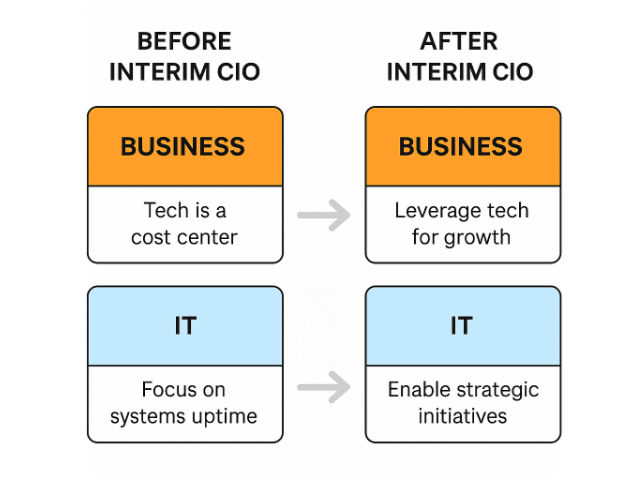“Technology is nothing. What’s important is that you have a faith in people, that they’re basically good and smart, and if you give them tools, they’ll do wonderful things with them.”
— Steve Jobs
Technology is evolving at a breakneck pace, leaving many companies struggling to keep up. When systems are misaligned, talent is underleveraged, and business leaders are frustrated, it’s often a sign that technology is being managed in a silo—or worse, it’s actively hindering growth.
We spoke with two seasoned interim CIOs, David Mitchelhill and Kevin Malover, both members of the InterimExecs RED Team, about how they’ve guided companies through ERP overhauls, tech stack rebuilds, and aligning IT with business goals. Here are the biggest takeaways.
Seeing the Bigger Picture
Interim CIO David Mitchelhill says the biggest challenge comes when the organization wants to go one way and the IT team that is either behind the curve or operating in its own silo.
“I’ve had discussions with companies over many, many years, where they say, ‘We spent a fortune on our legacy system over the last 20 years. We’re really used to it and we like it,’” Mitchelhill says. “The realization that the world has changed is quite often a very difficult thing for companies to accept.”
The challenge of integrating technology with business strategy is huge, he says. When IT is seen only as a cost center, investments tend to focus on maintaining systems rather than enabling innovation. That’s where interim CIOs provide clarity.
Without strong executive support and clarity of mission, companies end up with tech spend that doesn’t move the needle, Mitchelhill says.
An Outsider’s Advantage
Interim CIO Kevin Malover highlights the power of a fresh perspective an outsider can bring.
People are more open to sharing where the problems are when they’re talking to an interim CIO, he says.
“I can say things others can’t. And I’m not worried about protecting turf or climbing the corporate ladder. I’m there to solve the problem.”
That honesty, combined with cross-industry experience, allows interim CIOs to quickly see what’s working and what isn’t, to challenge outdated assumptions and redirect organizations toward value-driven technology decisions.
“One of the first things about an interim is he’s going to tell you the truth,” Mitchelhill says. “He’s not there to make your life comfortable. He’s there to make it less safe, if anything.”
From Assessment to Execution
The value of an interim CIO isn’t just in assessment. It’s in execution.
“When I come in, I’m not just assessing the tech stack. I’m looking at the people, the org chart, the decision-making process, vendor contracts, how information flows,” Mitchelhill says. “Because that’s where transformation really begins.”
Technology alone won’t solve business problems. But technology led by strategic, results-oriented leadership? That’s where the real impact happens.
“People ask, ‘What’s your IT strategy?’” Malover says. “Well, that’s the wrong question really. The question should be, ‘What’s your business strategy and how’s IT going to enable that?’”
_________
Is your organization in need of top-tier tech help? Reach out to us for a confidential conversation about how a RED Team Interim CIO can solve your tech problems.
Read More:







